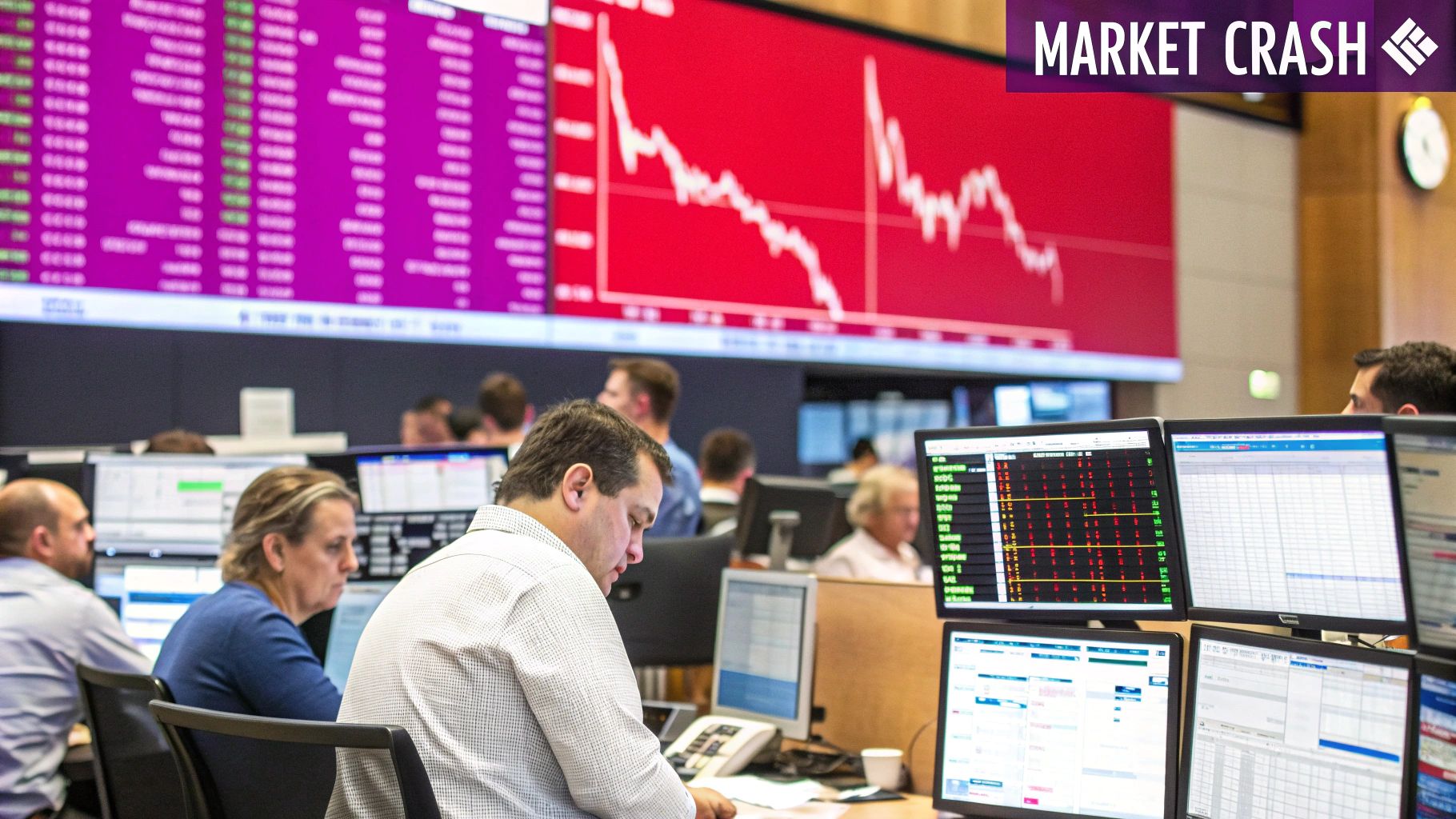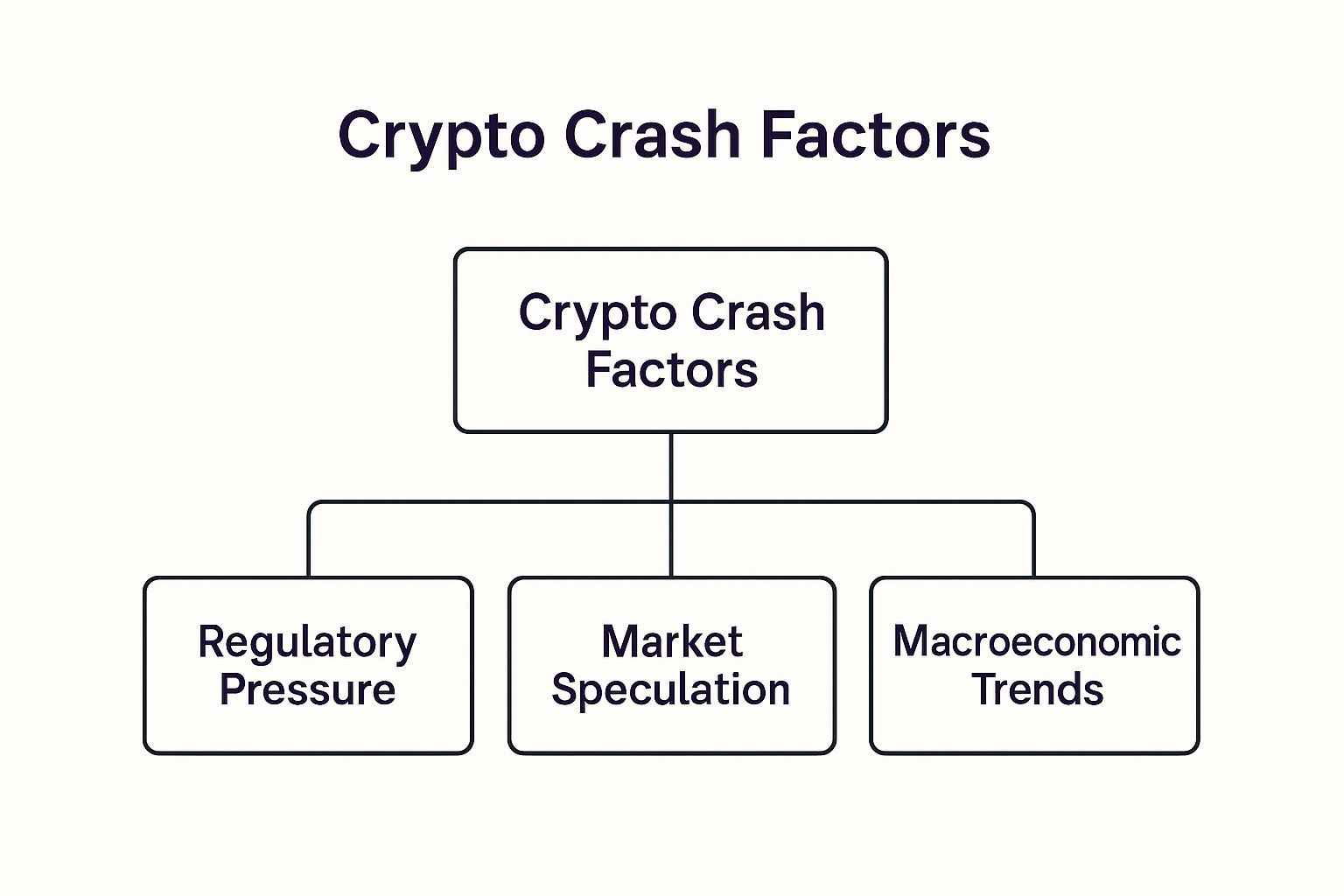A crypto crash hardly ever stems from just one thing. It's more like a perfect storm where economic pressure, regulatory clampdowns, and weaknesses inside the crypto world itself all collide, creating a domino effect. These forces feed on each other, quickly turning market jitters into a full-blown, panic-selling firestorm.
What Really Causes a Crypto Market Crash

To really get what makes the crypto market tumble, you have to look past the day’s headlines. The market is a delicate system where several big-picture factors are constantly in play. A major downturn isn’t usually a shock; it's the final straw after weeks or months of mounting pressure.
We can break down the main culprits into three buckets. First, you've got the huge macroeconomic shifts that impact every financial market, not just crypto. Then there are the regulatory moves, where a government decision can sour sentiment in an instant. And finally, you have the internal issues—the risky business happening right inside the crypto ecosystem.
The Perfect Storm of Crash Factors
When the global economy starts looking shaky, investors get nervous and go "risk-off." They dump volatile assets like crypto and run for the perceived safety of government bonds or just plain cash. The main triggers for this are usually:
- Rising Interest Rates: When central banks hike rates to tame inflation, suddenly boring old savings accounts and bonds look a lot more appealing. This sucks money directly out of high-risk, high-reward markets like crypto.
- Widespread Economic Fear: Talk of a recession or global instability spooks everyone, from big institutional players to everyday traders, causing them to slash their exposure to anything speculative.
A crypto crash is the market’s brutal way of clearing out all the excess speculation. It painfully resets prices, separating the projects with real substance from those built on nothing but hype.
An unexpected regulatory crackdown can send shockwaves through the market. Even just the rumor of new rules can be enough. If a major government suddenly bans crypto mining or starts labeling popular tokens as securities, it injects a massive dose of uncertainty that terrifies investors.
Last but not least, the crypto market can often be its own worst enemy. When too many traders use excessive leverage—borrowing money to make bigger bets—it builds a house of cards. A small dip in price can set off liquidation cascades, a nasty chain reaction where forced selling triggers more forced selling, pushing prices into a freefall. Staying on top of the latest moves is critical, which is why keeping an eye on up-to-date crypto news and analysis is so important.
Any one of these factors can cause a dip. But when they all happen at once, you’ve got the makings of a full-blown crash.
To make sense of it all, here's a quick look at the main forces behind a crypto market crash and how they tend to play out.
Key Drivers Behind a Crypto Crash
A quick summary of the primary forces that contribute to major cryptocurrency downturns and their direct impact on the market.
| Driver | Description | Immediate Impact |
|---|---|---|
| Macroeconomic Pressure | Global economic downturns, rising interest rates, and inflation cause investors to move away from volatile assets. | Capital flows out of crypto and into safer assets like bonds and cash, causing widespread selling. |
| Regulatory Crackdowns | Governments introduce new, restrictive rules, ban crypto activities, or classify tokens as securities. | Creates massive uncertainty and fear, leading to panic selling as investors worry about the future legality of their assets. |
| Internal Market Dynamics | Excessive leverage, hacks on major exchanges, or the collapse of a large project creates systemic risk. | Triggers forced liquidations (cascades) and a loss of trust within the ecosystem, accelerating the price drop. |
| Negative Market Sentiment | A wave of fear, uncertainty, and doubt (FUD) spreads rapidly on social media and in the news. | Amplifies panic and encourages retail investors to sell, often at a loss, adding to the downward pressure. |
Ultimately, these factors don't operate in a vacuum. A hint of regulatory trouble can amplify the fear from a shaky economy, creating a vicious cycle that's tough to break.
How Global Economics Rattle Crypto Prices

It’s easy to think of crypto as its own universe, operating on its own rules. But the truth is, despite its decentralized ideals, the crypto market doesn't exist in a bubble. It's deeply plugged into the shocks and tremors of the traditional global economy.
When mainstream finance catches a cold, crypto often gets a nasty flu.
Think of the broader economy as a vast, powerful ocean and the crypto market as a much smaller, faster boat. When huge waves of economic change start rolling in—like shifting interest rates or inflation jitters—that little crypto boat gets tossed around far more violently than the big, stable container ships of traditional finance.
The Great Migration to Safety
When economic uncertainty hits, investors everywhere get spooked. This isn’t just a crypto thing; it’s human nature. They scramble to pull their money out of what they see as speculative, high-risk assets—like tech stocks and, of course, cryptocurrencies—and park it in safer harbors. This classic move is known as a “flight to safety.”
So, what exactly counts as a safe harbor in a storm?
- Government Bonds: These are essentially loans you make to a government, which are considered one of the most secure investments you can find because they pay a fixed interest rate.
- Cash: Sometimes, the best move is just holding onto stable currencies like the US dollar. It protects your capital from the wild swings of a volatile market.
This is where central banks, like the U.S. Federal Reserve, come into play. When they raise interest rates to fight inflation, those "safe" investments suddenly look a lot more attractive. This gives institutional investors a huge incentive to dump their risky crypto holdings and chase those safer returns, often triggering a market-wide sell-off that leaves everyone asking, "Why is the crypto market crashing?"
Before making any moves, it’s crucial to understand the rules of the game and the risks involved, which are detailed in our terms and conditions.
A tell-tale sign of shaky confidence is when you see massive outflows from Bitcoin spot ETFs. These funds are the primary on-ramps for big institutional money. When those players start pulling out, it’s a clear signal that their faith in crypto as a stable asset is dwindling.
This creates a domino effect. A sudden, sharp drop in the total crypto market capitalization isn't just one coin falling; it reflects a broad sell-off across almost every token. This is usually fueled by a cocktail of macroeconomic fears: central banks being wishy-washy on interest rates, worries over global trade tariffs, and nagging, persistent inflation.
Inflation: The Double-Edged Sword
Inflation has a complicated relationship with crypto. On one hand, many investors flock to Bitcoin, hailing it as “digital gold.” The idea is that it will hold its value while traditional currencies lose their purchasing power. This is the classic inflation hedge argument.
But reality is rarely that simple.
When inflation truly spirals out of control, it doesn't create confidence; it creates widespread economic panic. Central banks hit the emergency brake by aggressively hiking interest rates. As we just saw, this makes safer investments far more appealing. The overwhelming fear in the market often suffocates the "digital gold" narrative, causing even the staunchest believers to sell their crypto.
When the Crypto Market Becomes Its Own Worst Enemy
While global economics and regulations are massive external forces, some of the most spectacular crypto crashes are an inside job. The market’s own internal mechanics can create a powder keg of risk, where one tiny spark sets off a devastating chain reaction.
These are the moments that make you wonder, "why is the crypto market crashing so violently?" Often, the answer is that the system’s complexity and lack of guardrails have turned against it, causing it to collapse under its own weight. This happens when risky behaviors become so common that the entire ecosystem turns into a house of cards, ready to fall at the slightest tremor.
This infographic breaks down some of the core factors that can spark a crypto crash.

As you can see, market speculation is just as powerful as macroeconomic trends and regulatory pressure when it comes to driving downturns.
The Domino Effect of Liquidation Cascades
One of the most destructive internal forces is overleveraging. Picture a trader who wants to make a $100,000 bet on Bitcoin but only has $10,000 in their account. They can borrow the other $90,000 from an exchange, a practice known as trading with leverage. If Bitcoin’s price climbs, their profits are magnified tenfold.
But if the price drops, so do their losses. A dip of just 10% is enough to completely wipe out their initial $10,000. To protect itself, the exchange automatically force-sells the trader’s Bitcoin to cover the loan. This is a liquidation.
Now, imagine thousands of traders are all overleveraged in the same way. A small price dip triggers a wave of these automated liquidations. The large sell orders push the price down even further, which in turn triggers the next wave of liquidations for other traders.
This is a liquidation cascade: a vicious, self-perpetuating cycle of forced selling that causes prices to spiral downwards with terrifying speed. It's a domino effect that can erase billions in market value in a matter of hours.
The Hidden Risk of Contagion
The crypto ecosystem is far more interconnected than it looks on the surface. Countless decentralized finance (DeFi) protocols, lending platforms, and exchanges are quietly dependent on one another, creating a hidden danger known as contagion risk.
Think of the market as a spider's web. If one major strand breaks—say, a massive DeFi lender becomes insolvent—it doesn't just vanish. Its failure yanks on all the other strands it was connected to, sending shockwaves of stress across the entire system.
- Example 1: A lending protocol might hold billions of dollars worth of another project's token as collateral. If that token's value suddenly collapses, the lending protocol could find itself insolvent overnight.
- Example 2: An exchange might have significant exposure to a DeFi platform that gets hacked. The exchange's losses could force it to halt withdrawals, trapping user funds and igniting widespread panic.
The market's vulnerability to flash crashes often boils down to this dangerous cocktail of overleveraging and hidden contagion risks. Since crypto has no central authority to step in and stop the bleeding, these systemic shocks can spread much faster and more violently than in traditional finance.
Mastering these concepts is crucial to understanding why the market can be so volatile. To continue building your knowledge, check out the helpful resources in our vTrader Academy.
The Psychology of Market Panic and Euphoria
When you strip away the complex charts and economic models, you’re often left with a simple, powerful driver behind a crypto crash: raw human emotion. In a market where narratives can trump fundamentals, the collective mood of investors becomes a force of nature, whipping up breathtaking booms and equally devastating busts. It’s a tale as old as markets themselves, powered by greed and fear.
It almost always starts with a wave of pure euphoria. A token starts to climb, then it picks up speed. As prices go parabolic, stories of overnight millionaires flash across social media, igniting a serious case of Fear Of Missing Out (FOMO). This isn't just a hashtag; it’s a powerful market force that sucks in everyday people, all desperate to catch a rocket to the moon.
From Greed to Uncontrollable Fear
This wild rush of excitement shoves valuations into the stratosphere, far beyond what’s sustainable. The market gets caught in a dangerous feedback loop: rising prices pull in more buyers, which only pushes prices higher. At the peak of this frenzy, logic gets tossed out the window, replaced by a shared delusion. But that foundation is as fragile as glass.
All it takes is one crack to shatter the whole thing. A negative headline, a rumor of a regulatory crackdown, or a major project showing signs of trouble can flip the switch from greed to fear in an instant. Suddenly, the story that everyone believed in starts to fall apart.
This is the moment of truth. The same traders who piled in out of FOMO are now the first to stampede for the exits, terrified of watching their gains evaporate.
A crypto crash is the market’s brutal way of hitting the reset button. When euphoria sends prices into orbit, completely detached from reality, a correction isn’t just likely—it's guaranteed. Fear is what pulls the market back down to earth.
This pattern is almost predictable. The most epic bull runs, fueled by intense greed and wild speculation, ironically lay the groundwork for the most painful crashes when the music finally stops. You can find more insights on this cycle and why the crypto market crashes after periods of extreme optimism.
This sudden shift triggers panic selling—a herd-like rush where investors dump assets frantically, no longer caring about their underlying value.
How Social Media Pours Fuel on the Fire
In the modern market, social media and clickbait headlines are gasoline on the fire, amplifying both the giddy highs and the terrifying lows. During a downturn, these platforms become an echo chamber of pure dread.
Here’s how it usually plays out:
- The Initial Shock: A prominent influencer or crypto news outlet flags the initial price drop, often with a dramatic, fear-inducing headline.
- Rapid Amplification: The news explodes across platforms like X (formerly Twitter) and Reddit, where fear spreads like a virus.
- Emotional Contagion: As more people watch their portfolios turn red, they join the panicked chorus, creating a self-feeding loop of negativity.
This cycle can morph a minor dip into a full-blown market meltdown in just a few hours. The constant flood of bad news and panicked posts can unnerve even the most seasoned holders, pressuring them to sell and adding more fuel to the downward spiral.
How to Navigate a Market Downturn Like a Pro

Knowing why the crypto market is crashing is one half of the puzzle. The other, arguably more important half, is knowing what to do about it. Market downturns are terrifying, but they’re also a completely natural part of the cycle.
Panicking is easy. It’s the human thing to do. But staying strategic is what separates successful investors from the herd that gets shaken out.
This isn't financial advice, but a playbook for building resilience. The real goal is to switch your brain from reactive fear to proactive, logical decision-making. Surviving a bear market—and even thriving in one—boils down to having a solid plan before the panic kicks in.
Define Your Investment Thesis
Before you even think about "buying the dip," you need to have a rock-solid investment thesis. Why did you buy that specific coin or token in the first place? Was it for the groundbreaking technology, its potential as an inflation hedge, or a specific use case in the world of DeFi?
Your thesis is your anchor in a storm. If the core reasons you invested still hold true despite the price getting hammered, sticking to your plan becomes much easier. If something fundamental has changed and the thesis is broken, then it might be time to reassess. The key is that the decision comes from logic, not fear.
A strong thesis should answer these questions:
- What real-world problem does this asset actually solve?
- What is its genuine long-term potential for growth?
- Do I still believe in its future, even at this much lower price?
The Power of Dollar-Cost Averaging
Let's be honest: trying to perfectly time the bottom of a crash is a fool's errand. Even the pros get it wrong. A much less stressful—and often more effective—strategy is dollar-cost averaging (DCA).
This simply means investing a fixed amount of money at regular intervals. For example, you might decide to buy $100 worth of an asset every Friday, no matter what the price is doing.
When the market is down, your fixed investment buys more coins. When it’s up, it buys less. Over time, this discipline smooths out your average entry price and dramatically cuts the risk of dropping a huge sum of money right at a market peak. It takes emotion completely out of the equation.
A market crash is the ultimate test of conviction. It’s what reveals whether you're an investor with a long-term vision or just a speculator who was along for the ride. The choices you make during these periods will define your portfolio's success far more than anything you do in a bull run.
For those with long-term conviction, downturns can be about more than just buying. They're also a prime time to earn passive yield. Exploring options like crypto staking can help you grow your holdings even when prices are moving sideways. You can learn more about how staking can work for your portfolio to see if it fits your strategy.
Diversification Is Your Best Defense
Finally, we need to talk about real diversification. Holding a dozen different meme coins isn't diversification; it's just concentrating all your risk in the most volatile corner of the market. A genuinely diversified portfolio spreads risk across different types of assets.
This might mean balancing established cryptocurrencies like Bitcoin and Ethereum with cash reserves or even traditional assets completely outside of crypto. The goal is to make sure a catastrophic drop in one asset doesn't wipe you out.
By building this framework—a clear thesis, disciplined buying, and smart diversification—you can navigate a crypto crash with confidence instead of fear.
Answering Your Top Questions About Crypto Crashes
When prices are in a freefall, the same questions always seem to pop up as traders and investors try to make sense of the chaos. Getting a handle on the typical patterns of a market crash is absolutely vital for managing your emotions and making moves that are logical, not reactionary.
Let's dive into the most common questions that come up when the charts turn red. These straightforward answers will give you the context you need to really grasp what’s happening in the market.
How Long Do Crypto Crashes Usually Last?
A crypto crash, what many call a "crypto winter," doesn't have a set expiration date. Looking back at history, these brutal downturns have stretched anywhere from a few months to more than two years. The crash that followed the 2017 bull run peak, for instance, didn't really let up until late 2020.
The timeline really hinges on what caused the crash in the first place. If it was triggered by too much leverage in the system, it might resolve faster once all the over-extended speculators get wiped out. But if the downturn is tangled up with a global recession or a harsh regulatory crackdown, the recovery is likely to be a much longer, grinding process. It all comes down to how long it takes for confidence and fresh capital to flow back into the market.
Is Buying During a Crypto Crash a Good Idea?
The classic strategy of "buying the dip" is a favorite among long-term believers who hope to scoop up assets at a major discount. The logic is simple enough: buy low now, assuming that prices will not only recover but eventually soar past their old highs.
This approach, however, is loaded with risk. It's practically impossible to know when the market has truly hit rock bottom—a falling knife can always fall further.
A more disciplined strategy is dollar-cost averaging (DCA). This just means you invest a fixed amount of money at regular intervals, no matter what the price is doing. DCA takes the emotional guesswork out of the equation and smooths out your average entry price over time, which drastically reduces the risk of dumping all your cash in at the worst possible moment.
Of course, this only works if you have strong, long-term conviction in the future of the asset you're buying.
How Are Altcoins Affected During a Bitcoin Crash?
When the whole market takes a nosedive, altcoins—basically any crypto that isn't Bitcoin—almost always get hit much, much harder than Bitcoin itself. This happens because Bitcoin is seen by most as the market's core benchmark and the "safest" bet in the crypto space.
As fear takes hold, you see a "flight to safety" happen right within the crypto market. Traders and investors will often dump their riskier, more speculative altcoin positions first. From there, they either move their money into Bitcoin, shift to stablecoins to wait it out, or pull their capital out of the market entirely. This is exactly why you'll see altcoins bleed out with much deeper percentage losses than Bitcoin during a crash. On the flip side, it's also why they often rocket past Bitcoin during a raging bull market.
What Is a Black Swan Event in Crypto?
A "black swan" is an event that is so rare and unpredictable it seems impossible before it happens, and its impact on the market is nothing short of catastrophic. These events are so far outside the realm of normal expectations that they trigger absolute, widespread panic.
In the world of crypto, a black swan could be something like:
- The sudden, shocking collapse of a huge, well-regarded exchange that everyone thought was stable.
- A coordinated and unprecedented global ban on crypto by the world's major economic powers.
- The discovery of a fundamental, unfixable flaw in the code of a major blockchain like Bitcoin or Ethereum.
These are a world apart from a standard crash, which is often caused by a predictable mix of things like high leverage and a shaky economy. By its very definition, nobody sees a black swan coming.
For more detailed answers to other common questions, you can always explore a comprehensive crypto FAQ page to expand your knowledge.

Steve Gregory is a lawyer in the United States who specializes in licensing for cryptocurrency companies and products. Steve began his career as an attorney in 2015 but made the switch to working in cryptocurrency full time shortly after joining the original team at Gemini Trust Company, an early cryptocurrency exchange based in New York City. Steve then joined CEX.io and was able to launch their regulated US-based cryptocurrency. Steve then went on to become the CEO at currency.com when he ran for four years and was able to lead currency.com to being fully acquired in 2025.


